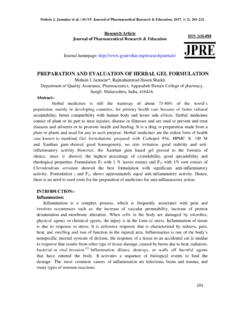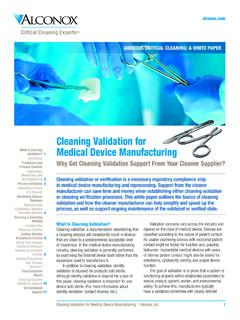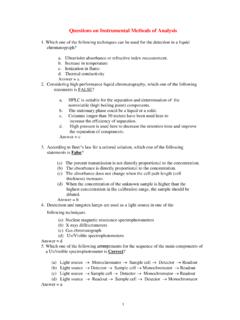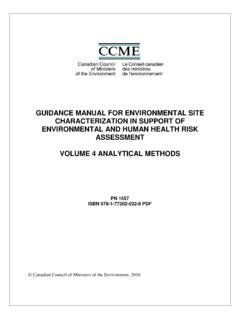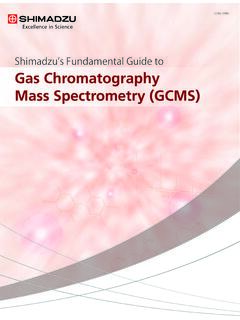Transcription of HPLC METHOD DEVELOPMENT -A REVIEW
1 Pallaviet of PharmaceuticalResearch &Education, 2017, 1(2), 243-260243 ReviewArticleJournal of Pharmaceutical Research & EducationJournal homepage: METHOD DEVELOPMENT -AREVIEWMs Pallavi Nemgonda Patil*Suresh GyanViharUniversity,Jaipur, may be utilized as the basis for decisions relating to administering the drug to patients,play important roles in new discovery, DEVELOPMENT , manufacture of pharmaceutical drugs andvarious other studies related to humans and METHOD validation requiredduring drug DEVELOPMENT and manufacturing and these analytical methods are fit for theirintended purpose.
2 To comply with the requirements of GMP pharmaceutical industries shouldhave an overall validation policy which documents howvalidation will be mainly focuses on the optimization of hplc sequence of events requiredfor METHOD DEVELOPMENT and analytical validation are Words: hplc ,Analytical METHOD validation, Pharmaceuticalanalysis, Specificity,Precision, CHROMATOGRAPHYP artition chromatography can be subdivided into(i) liquid - liquid chromatography and(ii) bonded-phase chromatography . With liquid - liquid , a liquid stationary phase is retained on the surface of the packing byphysical adsorption.
3 With bonded-phase, the stationary phase is bonded chemically to the support partition chromatography was the liquid - liquid type; now the bonded-phase METHOD hasbecome predominate because of certain disadvantages of liquid - liquid systems. One of these disadvantages is the loss of stationary phase by dissolution in the mobilephase, which requires periodic recoating of the support particles. Furthermore, stationary-phase solubility problems prohibit the use of liquid -phasepackings for gradient of PharmaceuticalResearch &Education, 2017, 1(2), 243-260244 Columns for Bonded-Phase ChromatographyThe supports for the majority of bonded-phase packingsfor partition chromatography areprepared from rigid silica, or silica-based, compositions.
4 These solids are formed as uniform,porous, mechanically sturdy particles commonly having diameters of 3, 5, or 10 m. The surfaceof fully hydrolyzed silica is made up of chemically reactive silanol groups. The most usefulbonded-phase coatings are siloxanes formed by reaction of the hydrolyzed surface with anorganochlorosilaneFigure-1 hplc PARTSP allaviet of PharmaceuticalResearch &Education, 2017, 1(2), 243-260244 Columns for Bonded-Phase ChromatographyThe supports for the majority of bonded-phase packingsfor partition chromatography areprepared from rigid silica, or silica-based, compositions.
5 These solids are formed as uniform,porous, mechanically sturdy particles commonly having diameters of 3, 5, or 10 m. The surfaceof fully hydrolyzed silica is made up of chemically reactive silanol groups. The most usefulbonded-phase coatings are siloxanes formed by reaction of the hydrolyzed surface with anorganochlorosilaneFigure-1 hplc PARTSP allaviet of PharmaceuticalResearch &Education, 2017, 1(2), 243-260244 Columns for Bonded-Phase ChromatographyThe supports for the majority of bonded-phase packingsfor partition chromatography areprepared from rigid silica, or silica-based, compositions.
6 These solids are formed as uniform,porous, mechanically sturdy particles commonly having diameters of 3, 5, or 10 m. The surfaceof fully hydrolyzed silica is made up of chemically reactive silanol groups. The most usefulbonded-phase coatings are siloxanes formed by reaction of the hydrolyzed surface with anorganochlorosilaneFigure-1 hplc PARTSP allaviet of PharmaceuticalResearch &Education, 2017, 1(2), 243-260245 hplc classified ON MODE OF chromatography -stationary phase is polar (hydrophilic) and mobile face isnon-polar (hydrophobic).
7 Phase chromatography -stationary phase is non-polar (hydrophobic) and mobile faceisPolar (hydrophilic). Polar-Polar bonds and Non Polar-Non Polar bonds have more affinity than Polar-Non phase chromatography is more commonly used as drugs are usually hydrophilic ON PRINCIPLE OF SEPERATION chromatographyFigure-2 Absorption ChromatographyFigure-3 Ion-exchange chromatographyIt is a form of chromatography in which ions in solution can be "paired" or neutralized andseparated as an ion pair on a reversed-phase column. Ion-pairing agents are usually ionic compounds that contain a hydrocarbon chain thatimparts a certain hydrophobacity so that the ion pair can be retained on a gel permeation chromatography This type of chromatography lacks an attractive interaction between the stationary phase andsolute.
8 The liquid or gaseous phase passes through a porous gel which separates the moleculesaccording to its of PharmaceuticalResearch &Education, 2017, 1(2), ChromatographyFigure-4 Affinity chromatographyIt involves the separation of stereoisomers. In the case of enantiomers, these have no chemical orphysical differences apart from being three-dimensional mirror images. Conventionalchromatography or other separation processes are incapable of separating them. To enable chiralseparations to take place, either the mobile phase or the stationary phase must themselves bemade chiral, giving differing affinities between the BASED ON ELUTION elution:A separation that employs a single solvent or solvent mixture of elution:Here two or more solvent systems that differ significantly in polarity areemployed.
9 After elution is begun; the ratio of the solvents is varied in a programmed way,sometimes continuously and sometimes in a series of steps. Separation efficiency is greatlyenhanced by gradient ON SCALE OF HPLCNo recovery of individual components of HPLCI ndividual components of substance can be recoveredCONTENTS-1-21 ANALYTICAL METHODDEVELOPMENT[15-18]When there are no authoritative methods are available, new methods are being developed foranalysis of novel products. To analyze the existing either pharmacopoeial or non-pharmacopoeialproducts novel methods are developed to reduce the cost besides time for better precision andruggedness.
10 These methods are optimized and validated through trial runs. Alternate methods arePallaviet of PharmaceuticalResearch &Education, 2017, 1(2), 243-260247proposed and put into practice to replace the existing procedure in the comparative laboratorydata with all available merits and Purpose of analytical METHOD DEVELOPMENT [19].Drug analysis reveals the identification characterization & determination of the drugs inmixtures like dosage forms & biological fluids. During manufacturing process and drugdevelopment the main purpose of analytical methods is to provide information about potency(which can be directly related to the requirement of a known dose), impurity (related to safetyprofile of the drug), bioavailability (includes key drug characteristicssuch as crystal form, druguniformity and drug release ), stability ( which indicates the degradation products )
